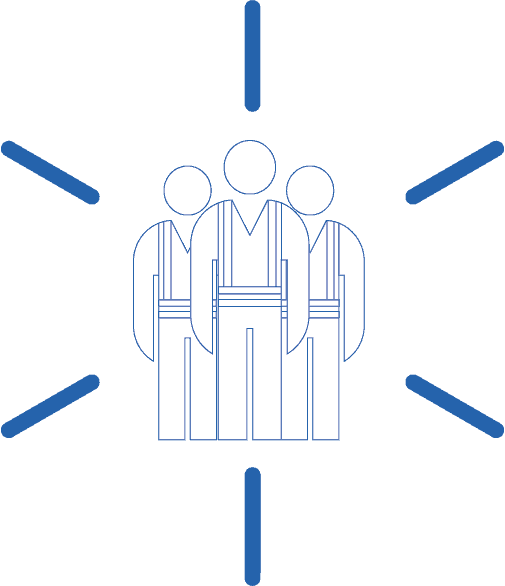6 River Systems FAQ
Basics
The core of the 6 River Systems solution is powered by autonomous mobile robots (we call them Chucks), cloud-based orchestration software and rich operational analytics via The Bridge online management console. The cloud software communicates with Chucks to coordinate all the work on your floor. The result? A fleet of Chucks working seamlessly and collaboratively with your associates to boost productivity of key warehouse operations including putaway, pick, sort and packout. Here’s an example of the benefits for picking:

- Induct
The process starts in earnest at induct. During induct, the cloud software assigns Chuck a group of orders optimized for highest pick density while also ensuring priorities and cutoff times are honored. Chuck steps the induct associate through the process of assigning containers to each Chuck shelf via intuitive on-screen instructions and put-to-light system. Containers can be any combination of totes, divided totes ("totelets"), trays or shipping containers and a wide range of containerization options are available including batching and consolidation. - Meet
Once all containers are assigned at induct, Chuck travels on his own to the picking area, where associates meet Chuck to begin the process of filling those empty containers. This autonomous travel eliminates the "long walk" for associates who typically pull carts from the induct/staging area out to the active pick area. Chuck will either drive to a designated meeting point close to the first pick location or, in applications where it makes sense, meet the associate directly at the pick location. Your induct associate stays where they are, ready to load up the next empty Chuck in the induct queue. - Picking
Once the associate meets Chuck, he leads them through a group of tasks, setting the optimal pace and path. Work is prioritized and assigned to associates through intelligent algorithms that maximize productivity by minimizing the steps in between tasks — like Google Maps for your warehouse.
Chuck collaborates with associates by showing important task information — item image, description, quantity, location, etc. — on a tablet-sized touchscreen display. Chuck's put-to-lights also illuminate to indicate which side of the aisle to pick from and which container to place the item into. Chuck’s on-board scanner captures all necessary product information, including lot and serial number, if needed — allowing operators to pick hands-free. Chuck can also be paired with a range of third-party wired, Bluetooth or ring scanners for applications that need it (location scanning, for example).
With the end goal of eliminating unnecessary walking, the system supports traditional, "static" zones and our patented, dynamic zones. Static zones force Chuck to be handed off to another associate whenever it crosses predefined boundaries in our map. Our unique dynamic zoning feature evaluates multiple aspects of the operation in real time at each pick stop to determine whether it makes sense to have the current associate follow this Chuck-1 to the next task or have them break off to nearby Chuck-2 and have Chuck-1 travel autonomously to the next task where another associate will badge-in to continue the work.
In both zoning approaches, Chuck can either travel to a pre-designated meeting point or directly to the next task, whichever makes the most sense for your application. - Takeoff
Once the pick run is complete, Chuck informs your picker where to find the next Chuck, and then travels autonomously to the next destination to begin unloading containers. The destination can be one of many take-off locations for packout or sort, or an exceptions area to resolve short picks. Once Chuck arrives at takeoff, he steps that associate through the container removal process via on-screen instructions and put-to-light. Once all takeoff locations are visited, the now-empty Chuck heads back to induct, where the cycle begins again. - Note for picks outside the reach of Chuck
For tasks which aren't a good fit for Chuck either due to product attributes or warehouse storage location, our Mobile Fulfillment app can be paired with any material handling equipment to leverage our optimization platform for those tasks as well.
Some manual pick operations employ large carts that can weigh over 300 pounds when fully loaded. Our autonomous mobile robot Chuck may look like a more typical cart, but Chuck is often actually 2x to 3x more efficient than even those larger, manual carts.
There are three areas of benefit we deliver:
1. Eliminate the long walk. By bringing work to the operators in the active area and then autonomously delivering fully loaded Chucks to take-off points, we eliminate the long walking of your associates between induct, pick and take-off areas. Depending on your warehouse layout, this can generate a 20-40% benefit on its own.
2. Reduce the in-aisle walk. Our cloud-based services quickly identify the right work to assign to Chuck in real-time, while also identifying opportunities for consolidation (batching). This decreases the steps your associates complete in between picks, speeding them up. Static and dynamic zones can further reduce in-aisle walking. In typical cart picking operations we often see a 30% or more reduction in walking using our work assignment algorithms.
3. Speed up the task. Our patented, system-directed approach makes all the steps in cart picking faster. With a modern and intuitive user interface, hands-free scanner, and setting the optimal path and pace of associates with no more fatigue of pulling heavy carts, Chuck can often reduce task times by 20-40%.
No. Associates only follow Chuck in their assigned area (zone). Chuck travels autonomously, without an associate, from induct to active, between zones, from active to takeoff and from takeoff back to induct.
None, which is one of the biggest appeals of our solution. We offer a drop-in replacement to your cart picking operation using your existing WiFi network and with no on-premise servers needed.
It depends on the size and layout of your warehouse, order volumes and profiles, the type of product you are shipping and your current workflow. The best way to find out how many Chucks you’d need is to contact us and one of our solutions executives will follow up with you.
Yes. The system can accommodate a wide range of sizes and types of containers including totes, totelets, trays, bins and shipping cartons. We also have advanced cartonization logic to select the most optimal container(s) for your orders and batches.
Nuts and Bolts
Yes. We integrate to any type of host system including directly to ERP software. We have completed implementations with leading providers and many custom systems. We offer a standard API using JSON and HTTPS or a set of adapters that allow us to interface with just about any type of message format (CSV, fixed width, XML) and transport (file, SFTP, HTTP, sockets). To get started, we only need task (picks or putaway) and product information, but we offer a number of additional messages to meet your requirements. Our systems integration experts will help you define the right specifications for your installation.
Our system can often more than double manual pick rates, but the benefits only start there. Customers generally realize significant benefits beyond rates including improvements in accuracy, SLA attainment, training overhead, wave planning man hours, and lower employee turnover.
Yes. Our system can benefit putaway, pick, sort and packout.
With the latest in battery technology for rapid recharging, Chuck doesn’t tire easily and can run 24/7 with minimal interruptions. Depending on payloads, Chuck can go 12 hours or more without a charge. Our cloud software orchestrates optimal Chuck charging which takes place autonomously with no manual intervention needed. The fleet's capacity accounts for charge times to meet your daily throughput requirements.
Yes. Many of our customers have multi-year rental agreements to support their business. If you are an existing customer, you can even rent additional Chucks during peak periods or leverage our Flex-Chuck program for a portion of your fleet to pay for capacity only when you use it.
Company Background
Our team is very experienced in fulfillment automation. The founders of our company came from Kiva Systems (now Amazon Robotics). Many of our engineers helped define and develop the goods-to-person solution technology that revolutionized warehouse robotics automation.
That heritage along with the experience of hardening our own system and processes through over 6 years of commercial deployments sets us apart from nearly every other collaborative AMR provider.
We formed in July 2015 and signed our first customers in 2016. Given we're based just outside of Boston, Chuck gets his name from the famous Charles River. And we even named the company after the fact that the Charles River is a six river system.
We're proud to have become a part of Ocado Intelligent Automation in 2023 which shares in our mission to make fulfillment faster with innovative products that generate immediate and lasting value for our customers.
Deployed to well over 100 sites, 6 River Systems' solutions operate across North America, Europe and the UK, fulfilling millions of units each week for 3PL, B2B, retail and other companies including Crate & Barrel, DHL, Distribution Management, GXO, NRI and many others.
6 River Systems was built from the very beginning to solve a real problem: help warehouses do more with less in the fastest, most flexible way possible. Sites with 6RS in place often achieve 60-70% of the productivity of a goods-to-person system at 20% of the cost. We applied a very basic approach to our design, using these rules even today as we think through new opportunities and functionality:
- Empower your associates. Develop a collaborative solution that gets the most out of your most valued resource. Automate the easy problems and let humans focus on the hard ones. It’s part of our core values.
- Focus on flexibility, then productivity. The cost of being inflexible in today’s fast-moving fulfillment market is much greater than the productivity you could squeeze out of the system if it were less flexible. By remaining flexible, we can enable your operations to be dynamic and respond to differences in product, order mix and even geography.
- No new infrastructure. This helps us reduce the cost of the system, speed up implementation and simplify operations with training taking only a handful of minutes.
The 6 River Systems solution is different in many ways to other mobile robotics solutions available on the market. Here is a summary of alternatives:
Goods-to-person robots:
Goods-to-person (Kiva-like, shuttle, others) warehouse robotics automation are designed to nearly eliminate walking by storing inventory on proprietary racking or totes and carrying or shuttling it to associates. This requires a lot of infrastructure, warehouse floor space and robots (10-15 per associate). You get high pick rates (300 uph) but it’s really expensive (upwards of $25 million).
Automated mobile robots (AMRs): Some automated mobile robots (AMRs) are used to transport goods from the end of the aisle to the packing area. These transport robots do provide some benefit by eliminating the costly "long-walk", but they fall short of really improving the pick rates or accuracy because associates are still using your existing WMS.
Swarm-approach based robots:
Finally, there are systems that swarm the floor with small mobile robots in a zone-pick operation. Robots wait by pick locations for associates. Meanwhile, associates are forced to hop from robot to robot in their zone. While this may appear productive, the high robot counts (3-8 per associate) and lack of directed workflow can lead to significant congestion in aisles and ultimately worse performance. In addition, the smaller form factor limits the types of products that can be picked and further drives up robot counts and costs.
No. In fact, they can be fully trained on Chuck in a matter of minutes. This allows you to potentially hire less experienced associates, or even those with disabilities, who may have been prevented from working with manual carts and RF guns.
- Have a question that’s not on the list? Email it to us at info.oia@ocado.com.


